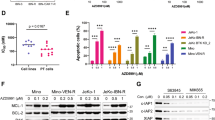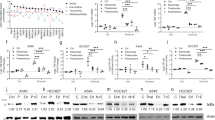Abstract
Primary effusion lymphoma (PEL) is a fatal malignancy, which typically presents as a lymphomatous effusion that later disseminates. Rapamycin (Rapa), which targets mTOR (mammalian target of Rapa), is currently evaluated as a treatment for PEL, but the recent development of PEL in Rapa-treated post-transplant recipients questions the drug's use in PEL. Here, we used a murine model of PEL effusion that mimics the human disease to investigate the anti-PEL activity of Rapa. We found that Rapa reduces ascites accumulation and extends mouse survival. Initially, Rapa reduced PEL load compared with control mice, but most mice rapidly showed PEL progression. Levels of VEGF, which promotes vascular permeability contributing to effusion formation, were significantly reduced in ascites of Rapa-treated mice compared with controls. Expression of IL-10, the principal autocrine growth factor for PEL, was initially reduced in PEL from Rapa-treated mice but rapidly increased despite treatment. We found that the hypoxic environment of ascites and Rapa cooperate in stimulating IL-10 expression in PEL, which likely contributes to the emergence of drug resistance. These results identify Rapa an effective drug to reduce PEL effusions but illustrate the rapid development of drug resistance, which likely limits the efficacy of Rapa in PEL.
This is a preview of subscription content, access via your institution
Access options
Subscribe to this journal
Receive 12 print issues and online access
$259.00 per year
only $21.58 per issue
Buy this article
- Purchase on Springer Link
- Instant access to full article PDF
Prices may be subject to local taxes which are calculated during checkout





Similar content being viewed by others
References
Cesarman E, Chang Y, Moore PS, Said JW, Knowles DM . Kaposi's sarcoma-associated herpesvirus-like DNA sequences in AIDS- related body-cavity-based lymphomas. N Engl J Med 1995; 332: 1186–1191.
Nador RG, Cesarman E, Chadburn A, Dawson DB, Ansari MQ, Sald J et al. Primary effusion lymphoma: a distinct clinicopathologic entity associated with the Kaposi's sarcoma-associated herpes virus. Blood 1996; 88: 645–656.
Simonelli C, Spina M, Cinelli R, Talamini R, Tedeschi R, Gloghini A et al. Clinical features and outcome of primary effusion lymphoma in HIV-infected patients: a single-institution study. J Clin Oncol 2003; 21: 3948–3954.
Guba M, von Breitenbuch P, Steinbauer M, Koehl G, Flegel S, Hornung M et al. Rapamycin inhibits primary and metastatic tumor growth by antiangiogenesis: involvement of vascular endothelial growth factor. Nat Med 2002; 8: 128–135.
Guertin DA, Sabatini DM . Defining the Role of mTOR in Cancer. Cancer Cell 2007; 12: 9–22.
Wullschleger S, Loewith R, Hall MN . TOR signaling in growth and metabolism. Cell 2006; 124: 471–484.
Sarbassov DD, Ali SM, Sabatini DM . Growing roles for the mTOR pathway. Curr Opin Cell Biol 2005; 17: 596–603.
Huang S, Houghton PJ . Inhibitors of mammalian target of rapamycin as novel antitumor agents: from bench to clinic. Curr Opin Investig Drugs 2002; 3: 295–304.
Stallone G, Schena A, Infante B, Di Paolo S, Loverre A, Maggio G et al. Sirolimus for Kaposi's sarcoma in renal-transplant recipients. N Engl J Med 2005; 352: 1317–1323.
Sin SH, Roy D, Wang L, Staudt MR, Fakhari FD, Patel DD et al. Rapamycin is efficacious against primary effusion lymphoma (PEL) cell lines in vivo by inhibiting autocrine signaling. Blood 2007; 109: 2165–2173.
Boulanger E, Afonso PV, Yahiaoui Y, Adle-Biassette H, Gabarre J, Agbalika F . Human herpesvirus-8 (HHV-8)-associated primary effusion lymphoma in two renal transplant recipients receiving rapamycin. Am J Transplant 2008; 8: 707–710.
Aoki Y, Narazaki M, Kishimoto T, Tosato G . Receptor engagement by viral interleukin-6 encoded by Kaposi sarcoma-associated herpesvirus. Blood 2001; 98: 3042–3049.
Nagy JA, Morgan ES, Herzberg KT, Manseau EJ, Dvorak AM, Dvorak HF . Pathogenesis of ascites tumor growth: angiogenesis, vascular remodeling, and stroma formation in the peritoneal lining. Cancer Res 1995; 55: 376–385.
Aoki Y, Tosato G . Role of vascular endothelial growth factor/vascular permeability factor in the pathogenesis of Kaposi's sarcoma-associated herpesvirus-infected primary effusion lymphomas. Blood 1999; 94: 4247–4254.
Phung TL, Ziv K, Dabydeen D, Eyiah-Mensah G, Riveros M, Perruzzi C et al. Pathological angiogenesis is induced by sustained Akt signaling and inhibited by rapamycin. Cancer Cell 2006; 10: 159–170.
Bucci M, Roviezzo F, Posadas I, Yu J, Parente L, Sessa WC et al. Endothelial nitric oxide synthase activation is critical for vascular leakage during acute inflammation in vivo. Proc Natl Acad Sci USA 2005; 102: 904–908.
Fukumura D, Gohongi T, Kadambi A, Izumi Y, Ang J, Yun CO et al. Predominant role of endothelial nitric oxide synthase in vascular endothelial growth factor-induced angiogenesis and vascular permeability. Proc Natl Acad Sci USA 2001; 98: 2604–2609.
Hatakeyama T, Pappas PJ, Hobson 2nd RW, Boric MP, Sessa WC, Duran WN . Endothelial nitric oxide synthase regulates microvascular hyperpermeability in vivo. J Physiol 2006; 574 (Part 1): 275–281.
Eliceiri BP, Paul R, Schwartzberg PL, Hood JD, Leng J, Cheresh DA . Selective requirement for Src kinases during VEGF-induced angiogenesis and vascular permeability. Mol Cell 1999; 4: 915–924.
Jones D, Ballestas ME, Kaye KM, Gulizia JM, Winters GL, Fletcher J et al. Primary-effusion lymphoma and Kaposi's sarcoma in a cardiac-transplant recipient [see comments]. N Engl J Med 1998; 339: 444–449.
Aoki Y, Jaffe ES, Chang Y, Jones K, Teruya-Feldstein J, Moore PS et al. Angiogenesis and hematopoiesis induced by Kaposi's sarcoma-associated herpesvirus-encoded interleukin-6. Blood 1999; 93: 4034–4043.
Foussat A, Balabanian K, Amara A, Bouchet-Delbos L, Durand-Gasselin I, Baleux F et al. Production of stromal cell-derived factor 1 by mesothelial cells and effects of this chemokine on peritoneal B lymphocytes. Eur J Immunol 2001; 31: 350–359.
Jones KD, Aoki Y, Chang Y, Moore PS, Yarchoan R, Tosato G . Involvement of interleukin-10 (IL-10) and viral IL-6 in the spontaneous growth of Kaposi's sarcoma herpesvirus-associated infected primary effusion lymphoma cells. Blood 1999; 94: 2871–2879.
Funahashi A, Sarkar TK, Kory RC . PO 2, PCO 2, and pH in pleural effusion. J Lab Clin Med 1971; 78: 1006.
Houston MC . Pleural effusion: diagnostic value of measurements of PO2, PCO2, and pH. South Med J 1981; 74: 585–589.
Luo JC, Yamaguchi S, Shinkai A, Shitara K, Shibuya M . Significant expression of vascular endothelial growth factor/vascular permeability factor in mouse ascites tumors. Cancer Res 1998; 58: 2652–2660.
Mesiano S, Ferrara N, Jaffe RB . Role of vascular endothelial growth factor in ovarian cancer: inhibition of ascites formation by immunoneutralization. Am J Pathol 1998; 153: 1249–1256.
Gerber HP, McMurtrey A, Kowalski J, Yan M, Keyt BA, Dixit V et al. Vascular endothelial growth factor regulates endothelial cell survival through the phosphatidylinositol 3′-kinase/Akt signal transduction pathway. Requirement for Flk-1/KDR activation. J Biol Chem 1998; 273: 30336–30343.
Mabuchi S, Altomare DA, Connolly DC, Klein-Szanto A, Litwin S, Hoelzle MK et al. RAD001 (Everolimus) delays tumor onset and progression in a transgenic mouse model of ovarian cancer. Cancer Res 2007; 67: 2408–2413.
Nepomuceno RR, Balatoni CE, Natkunam Y, Snow AL, Krams SM, Martinez OM . Rapamycin inhibits the interleukin 10 signal transduction pathway and the growth of Epstein Barr virus B-cell lymphomas. Cancer Res 2003; 63: 4472–4480.
Vaysberg M, Balatoni CE, Nepomuceno RR, Krams SM, Martinez OM . Rapamycin inhibits proliferation of Epstein-Barr virus-positive B-cell lymphomas through modulation of cell-cycle protein expression. Transplantation 2007; 83: 1114–1121.
Acknowledgements
Supported by the Intramural Research Program of the NIH, National Cancer Institute, Center for Cancer Research. PG supported in part by FIRC (Italian Foundation for Cancer Research). We thank Drs S Steinberg, K Ueda, R Yarchoan, S Pittaluga, D Whitby, S Sakakibara, M Segarra and P McCormick for help on aspects of this work.
Author information
Authors and Affiliations
Corresponding author
Additional information
Supplementary Information accompanies the paper on the Leukemia website (http://www.nature.com/leu)
Rights and permissions
About this article
Cite this article
Gasperini, P., Tosato, G. Targeting the mammalian target of Rapamycin to inhibit VEGF and cytokines for the treatment of primary effusion lymphoma. Leukemia 23, 1867–1874 (2009). https://doi.org/10.1038/leu.2009.117
Received:
Revised:
Accepted:
Published:
Issue Date:
DOI: https://doi.org/10.1038/leu.2009.117
Keywords
This article is cited by
-
Development and Significance of Mouse Models in Lymphoma Research
Current Hematologic Malignancy Reports (2019)
-
Multi-targeted therapy of everolimus in Kaposi’s sarcoma associated herpes virus infected primary effusion lymphoma
Apoptosis (2017)
-
Primary effusion lymphoma in an elderly patient effectively treated by lenalidomide: case report and review of literature
Blood Cancer Journal (2014)
-
Accumulation of dephosphorylated 4EBP after mTOR inhibition with rapamycin is sufficient to disrupt paracrine transformation by the KSHV vGPCR oncogene
Oncogene (2014)



